How To Catch Bass In Creeks
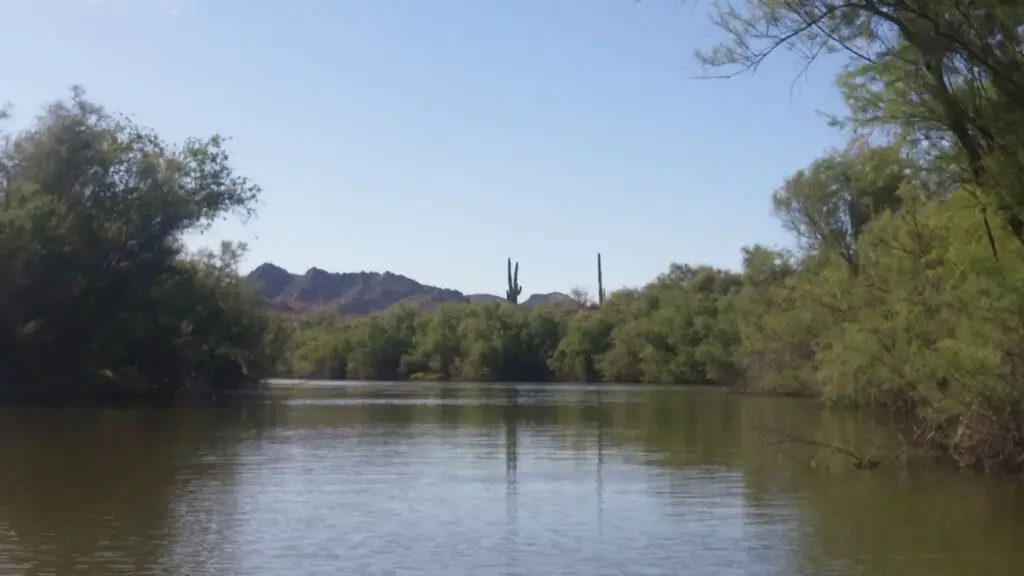
Are you finding it hard to catch (or even find) bass in creeks? All you have to do in order to start catching bass fishing in creeks is to find the correct location within the creek, select the correct bait, and know when and how to present the lure so you can quickly get a bite. Luckily, creek fishing is really easy to get into, and it’s not a technique that has a high barrier to entry… and… it certainly does not requires a ton of new gear to purchase. But it does take some time to learn… and… I’m sure you’ve seen other anglers pull out sacks of giant bass fishing creeks!
But, there is one indisputable piece of evidence that is true. Bass fishing creeks fishing is both a science and an art form. But over the years I’ve developed a super easy 5-step blueprint that helps me stay centered whenever I want to fish a creek or creek channel. It contains invaluable insights which I now totally embrace.
Key Takeaways
These techniques have become second nature to me now, they are the thoughts and strategies that automatically pop up anytime I need to pull into a creek to fish. Here are just some of the things you’ll learn in this creek fishing blueprint:
- What question and serious angler (like yourself) must ask when you get to the lake to start catching fish as fast as humanly possible!
- How your PC can get you extra bites when you’re on the water!
- The single best way ever to discover and find the perfect creek… and… catch fish fast!
- How you can legally check to see if bass are actually living in the creek you want to fish (not some other fish like crappie)… and… get your answer in less than 1 minute! This strategy helps you avoid spending countless hours on the wrong fishing spot!
- Learn the one-two punch for making an inactive bass bite – even Mike Tyson would be proud!
Have you ever got suckered into fishing the wrong creek?… I know I have!
Let me tell you a quick story… A long time ago, I used to pull into a creek thinking it was going to hold so many bass that I’d dull out all my hooks because I was going to catch so many fish!… but… the creek ends up being a bust… and come to think if it… even a ghost town has more life!
I would finish with the creek frustrated. I just wasted hours of my fishing day, and all I was left with was a sore arm from all the casts I made!
Can you relate? Have you ever fished the wrong creek? Sucks right?
So after years of fishing the wrong creeks and coming up short, I started to slowly develop, study, and learn from the best mentors to create a new way to approach a creek.
And in this fishing blueprint I originally made for myself, I’m giving it to you! I truly hope that it helps you get started fast… let’s dive in…
But be warned! Go through this blueprint slowly and carefully so you don’t miss any tips that could cost you.
Creek Fishing Primer | What Is a Creek Pertaining to Bass Fishing?
If you already know what a creek is and how it relates to bass fishing just skip to the next section below, but if you don’t keep reading…
Creek fishing is one of the oldest types of bass fishing techniques, used by many generations of anglers to catch smallmouth, spotted bass, and largemouth bass.
Unfortunately, thousands of anglers have tried fishing creek, only to move to a completely different type of spot.
Why? Because fishing a creek the right way is a closely guarded secret.
A creek channel is an area in a lake or river with a water level that has risen and become deeper over time. Creek channels can be found in reservoirs or other man made bodies of water.
Helpful Tip: The creek channel is a “road” on which bass travel to and from flats and swings to reach another area of the lake.
Creek channels have deep water close by so bass can move out to the deep water if necessary. They do this to escape from the bright sun on a hot day, or to follow their prey.
Bass fishing creek channels can be productive for anglers.
Why Fish a Creek for Bass?
A creek channel is often the best place to find bass because it provides shady spots for the bass to hide before ambushing their prey, and easy access to deeper water to reach spawning areas or ledges. Stumps, rocks, and grass attract bass to various spots in the channel.
Bass often travel to places where their prey go. They continually hunt and feed throughout the day. Fish may sit in place where the current washes prey into their resting areas.
Channel swings or bends are a place that many bass prefer. They often have current that brings higher levels of oxygenated water to the area.
Helpful Tip: A creek should have structure where bass can hide or stage. Good cover is desirable such as lay downs, boat docks, hanging overhead, and other areas where bass hide to catch their prey.
Bass fishing creek is productive for the angler in many different places on the creek. If the creek has various cover, twists and turns, it provides a variety of good spots for hooking into a lunker.
There may also be three or four bends in the creek channel, and most of them probably have bass close by. Each channel swing may have several prime spots for fishing bass.
This is helpful to anglers who want to make the most of their fishing time. Having three locations in one area cuts down on time.
Bass often stop at flat spots in creek channel bends that have rock piles or gravel piles. An angler can catch large bass as they travel from the channel to the main river channel.
Step 1: Find the Creek On Your Map – What Structural Features Do You Need to Look For?
One of the best ways for anglers to find structures underwater is with Google Earth. This website can show you how the topography of your lake looked at a time before the lake was formed, or there may have been a drought when the water receded.
From an aerial view, creeks can be straight or winding, and can look like the letter “S”, weaving its way into the main lake.
By looking at one of these maps of how the structure of the lake was formed in previous months or years, you can also find rock piles, ledges, flats, and other structures that can make creeks and creek channels productive.
These are now covered with water and cannot be seen.
Topographic maps are another way to find structures like creeks and creek channels in a lake or river. The contour lines tell how deep each area of the lake is.
It’s really easy finding the creek on your topographic map.
- Simply, pick a cove you’re interested in and look for the largest number on the topographic map. This signifies the deepest water in the cove.
- Next, verify it’s a creek, not a depression (hole in the ground). Make sure the contour lines that are extremely close together also appear to be running together for more than just a few hundred and appear to be winding toward the main lake is more than likely the creek channel. And the deepest contour line you find is more than likely the center of either a creek channel or a river channel.
- Then you want to look for areas that run up against shallow areas. These are considered the surrounding structures of the creek channel.
- If you see the contour lines are spread apart, this is probably a flat, or an area of shallow water.

In this example:
- Step 1: Find the deepest water.
- Step 2: Verify it’s a creek channel, not a depression (hole in the ground).
In the example below, you’ll see that there is a circular formation and drop in depth. The lines are not parallel and wind toward the main lake. This is not a creek channel, it’s a depression.
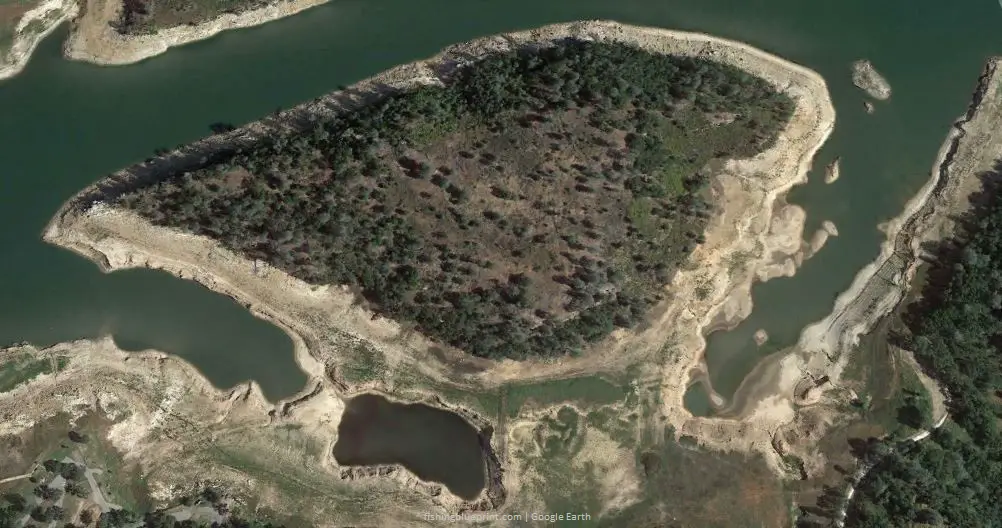
However in this example, you’ll see the contour lines that are extremely close together also appear to be running together for more than just a few hundred and appear to be winding toward the main lake, so by definition, it’s a creek channel.
There are various maps available to use on your fish finder to locate a channel creek. The Hummingbird Fish Finder offers maps of lakes in the entire country.
There is also a mobile app for your phone that enables you to take the maps to the lake with you. Also, the Navionics web app has hundreds of lake maps for anglers.
Helpful Tip: One great tip is to use Google Earth on your PC at home to find creeks and creek channels when the water is drawn down on your lake. Then you’ll also quickly and easily find any rock piles, ridges, maybe even a large brush pile that someone dropped into the lake when it was full.
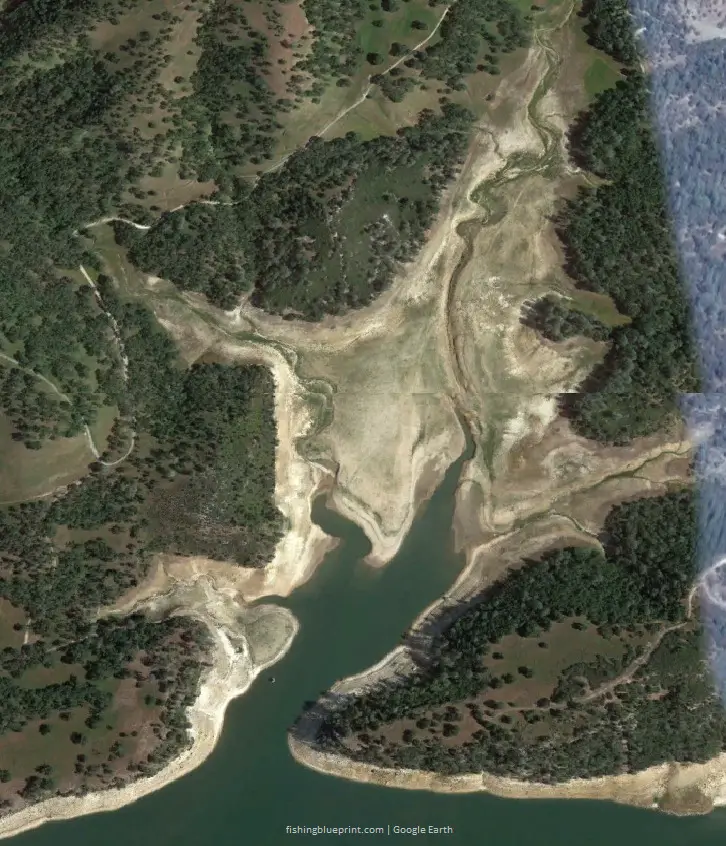
Above is a screenshot of Camanche Lake in California at low pool. Looking closely you can see the creeks and channels winding through the arm.
Step 2: Find the Best Section of the Creek So You Can Catch a Fish
As was mentioned briefly before, I consider bass fishing creeks and creek channels as forms of bass “highways”. My definition of a bass highway is anywhere in the lake that assists the bass to travel from spot to spot unimpeded is referred to as highways. Other highways can be large main lake channels or ledges, or smaller secondary drainage ditches that drain into a cove.
From my experience bass will only stay on a particular spot on a highway if it provides them with a good opportunity to hunt… otherwise they would go hungry and move somewhere else.
Think about it… if you go out to a restaurant and the restaurant runs out of food would you just sit there and wait? No, you would not. You would get up and go somewhere else. A bass does that same thing.
So what does a bass need in order to eat? A food source and an ambush location (or a hunting area).
That brings us to our next question? What does a bass consider a good ambush location?
Primary ambush locations are spots where bass can easily hunt for food and feel safe at the same time. They can be in the form of a hump, ridges, rock pile, brush pile, road bed and many, many more.
So what does this have to do with bass fishing creeks?
So when you get to the lake you must ask yourself, what creek has the best ambush locations on it? Because those spots tend to hold more fish, and therefore increase your chances of catching one of these fish.
Then all you need to do is then scan these intersections and find those mega-schools of bass. Because when you do, you can jaw-jack them over, and over, and over.
Step 3: Identify the Best Structures that Could Hold Bass on the Creek
Not all creeks are created equal… So what are the types of structures within the creeks you should look for?
If you’re new to fishing creeks, here is a list of my top 5 structures that will most likely hold bass. These are some of my best-guarded secrets:
- Solitary structure.
- Creeks with bends that run against a steep rocky bank.
- Intersecting or converging smaller creek channels.
- Grass flats or floating vegetation mats near a creek channel.
- Creeks with nearby ledges.
1. Solitary Cover
When the term solitary structure is mentioned, think about something that is abnormally bigger than anything else around, normally it’s hard, it has to be alone or away from everything, and can provide cover for the fish.
This can take the shape of many different things, however the most common solitary structures are a lone dock, a single laydown, an old single flooded tree (or a large stump), a big boulder, ect.
Question: Have you ever seen any solitary structures like this in your lake? These lone structures attract bass like crazy.
If there is nothing or very little cover opportunities, the bass will instinctively congregate to the largest structure to give them solitude.
Helpful Tip: It's the lone structures like docks or laydowns that fish will congregate underneath, especially if the structure is near deep water.
Bass will pull up out of the deep water and go up shallow during different times of the day and season.
What’s cool about fishing larger solitary structures is you can actually fish it you know all four sides.
I recommend a front to back approach.
- Start with the outside corners
- Second, fish the front
- Third, fish the sides
- Fourth, fish the back corners
- Fifth fish the deepest you can get your bait.
This is a tactic I learned from Strike King legend Denny Brauer. If you go for the deepest area you can first and lose the fish, the other fish around will get spooked and not bite.
Whereas, if you pick off the surrounding fish first, even if you miss a fish on the periphery, you still have a good chance to catch a fish the farther back you go.
2. Creeks with bends that run against a steep rocky bank.
Find large creek channel swings that come in contact with the bank.
Banks like these are typically associated with being rocky.
Rocky banks (also known as riprap banks) will hold bass all year long.
In the winter it’s gonna collect heat on cold days, especially if the bank is south facing. In response bass will swim up close to the rock to warm up.
Springtime, you better bet your bottom dollar that bass will spawn on rocky banks.
It gives places like crawfish, gobies, baby bass, bluegill and bream to hide out in those little nooks and crannies. In the summer you’ll see the bluegill and sunfish pecking at the algae. Needless to say, bass will hang out near or around rocky banks in the summer to pick off unsuspecting fish.
Fall is the time the bass will push schools of shad against steep rocky banks to gobble them up before winter.
Now do you see how riprap banks can be effective to fish all year long? Cool right?
Have you ever seen a really long rocky bank and just say to yourself, everything looks the same, where do I start?
One thing Edwin Evers has taught me about rocky banks is that I have to constantly be looking for any irregularity of the bank.
The irregularities don’t have to be big and obviously stand out, so it can be small and subtle.
Here’s a small list of things that I look out for when I fish a long riprap bank:
- Small contour changes like a point
- A turn in the bank – inward or outward
- A ledge or even a high spot that is close to the rocky bank
- Transitions changes of substrate – changes in size of the riprap on the bank (big or small)
- Rock slide
- Drainage ditches and culverts
- Laydowns
- Submerged brush
- An old flooded tree
It’s even better if the area has some form of artificial structure nearby like a dock, bridge piling, old road bed, boat ramps, ect, but it’s not required.
Here’s what I learned from experience when I want to fish a rocky bank in a creek:
- If I’m at home, I first look at Google Maps, then I’ll evaluate the big picture topography. I take note where the riprap bank is within the creek…
- Then, I look at my topographic maps for small changes in depth along that specific bank. I’ll look for drop offs, high spots, and ledges…
- Next, when I get on the water I slowly motor up and down the riprap bank evaluating it with my own eyes looking for the things that may be too small for Google Maps or a topographic map will not include…
- And while I’m doing that I’m scanning the bank with my sonar to confirm there’s fish living there.
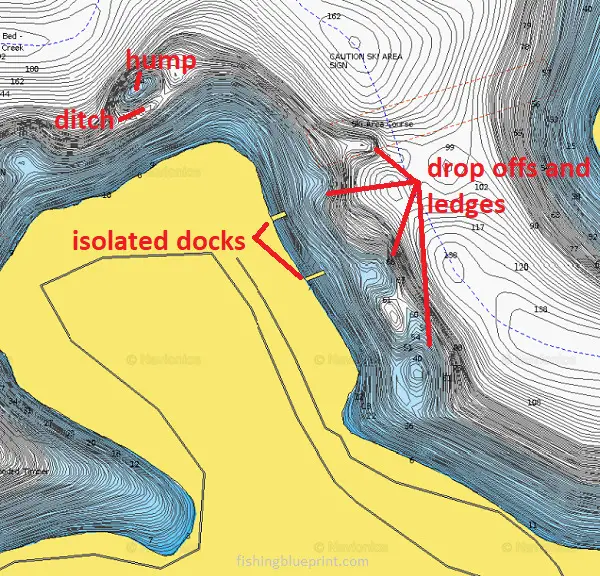
In each of these steps I’m saving waypoints from me to investigate when I’m on the lake.
It may seem tedious, but if you did your homework right, you end up saving a lot of time and you should have no problem ruling in, and more importantly… ruling out spots to fish.
3. Intersecting or Converging Smaller Creek Channels
As you move up into the cove you may notice multiple intersecting smaller creek channels. Anytime you see multiple intersecting creek channels it should get you excited because it gives you multiple opportunities to catch bass.
Focus on the point of the intersecting creek channels because it gives the bass the opportunity to travel quickly from deep water to shallow water to feed or stay warm or stay cool, depending on the time of year or weather conditions.
Additionally, if you can find any type of isolated structure such as a laydown, dock, or rockpile it provides you with an amazing opportunity to potentially catch a fish on it.
4. Creeks with Nearby Rocky Humps, Ridges and Ledges on Channel Swings
Creeks that will flow into a bay are commonly known to have multiple creek channels and multiple intersecting secondary structures all in one defined area.
Secondary structures can come in many forms such as:
- Rock substrate transitions (which are areas where the rock sizes will change/transition in size over a short distance.
- Rock piles
- Ridges/ high spots
- Ledges and drop offs
- Points
- Isolated brush piles
- Artificial fish habitats or sunken boats
It can be difficult to fish these areas because the bass will travel from one type of structure to another during different times of the year, season, week, or day.
BUT… So once you start catching bass on a specific structure on that day, chances are bass will be located on other pieces of similar structure in that same area.
So the game is to first figure out where the bass are in that given area, catch them, then quickly look for similar secondary structures and then fish those.
5. Creek with Bluff Walls
Creek with bluff walls are phenomenal to fish all year long, especially during the winter and summer
During the winter some of the shad on the wall may be dying and are not difficult for bass to catch.
On the other hand, during the summer bass will hide in pockets of shade provided by the bluff wall.
The best presentation for fishing bass on bluff walls in the winter or summer is to move your bait up and down to attract the bass. You can also cast until your bait hits the wall or the bottom of the lake and then move it back and forth to mimic live bait.
The biggest difference is how much you move your bait. In the winter smaller more subtle movements often get more bits. Whereas, more aggressive hops during the summer gets more bites.
If you don’t see any bass relating close to the bluff wall fish the riprap before and after the bluff wall.
Step 4: Identify the Creek With Your Fish Finder/ Sonar and Scan It
Hopefully, you did your homework and identified multiple creek channels to check out by looking at Google Earth or Google Maps
Now that you are on the water it’s time to find a quality creek to fish.
Scanning the shallow sections can be a little difficult, but scanning the creek channel with a fishing sonar is easy to do. This equipment can check the depth of water in a certain part of your lake as you drive your boat over the lake.
When you see a flat area fall to a deeper area, this is where the creek channel ledge will be located. It will look like a “V” between two flat parts of the lake or river on your electronics.
Red areas shown on your fish finder show flat areas with no or little change of depth within them.
When you find a creek channel edge, examine it to look for bass suspended above the ledge, or on the top or sides of the creek channel edge.
Lastly, take note if there are any bass at the lake bottom where the creek channel edge ends.
Bass will appear as arcs with spaces between each one on a fish finder. They are usually in a horizontal line and do not pile up more than two or three fish above another one.
Finding Active vs. Inactive Fish
When scanning a ledge you want to see the bass on top of the edge of the creek channel. This signifies the bass are actively feeding. These fish are extremely catchable anytime they are relating directly on top of creek channel edge, best of all you can typically catch them using an assortment of lures.
Look at the images below. This is a downward scan image I recreated to show you what bass look like when they’re relating on top of the ledge.
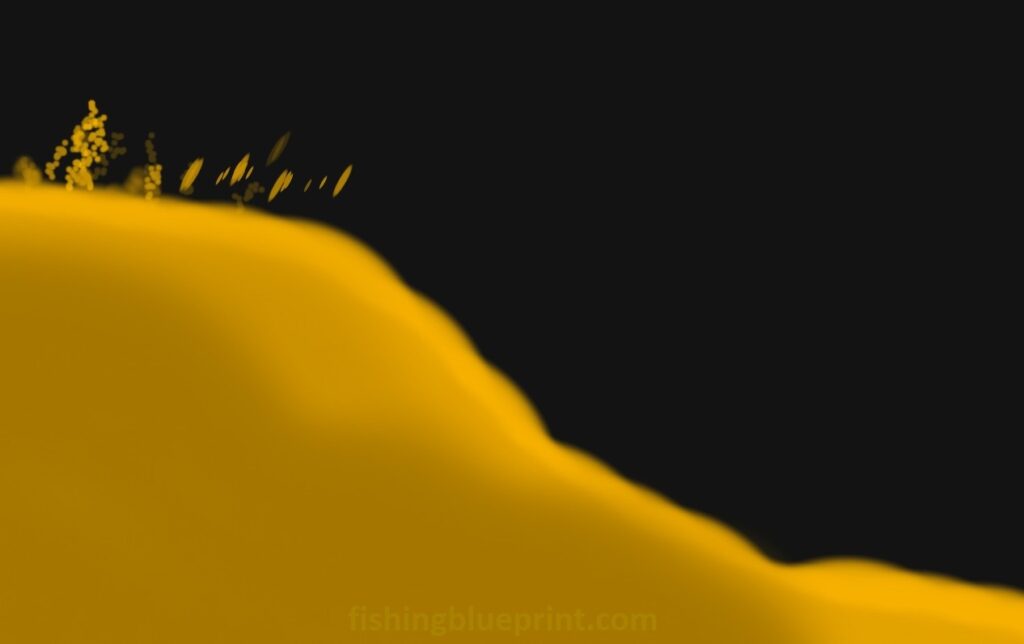
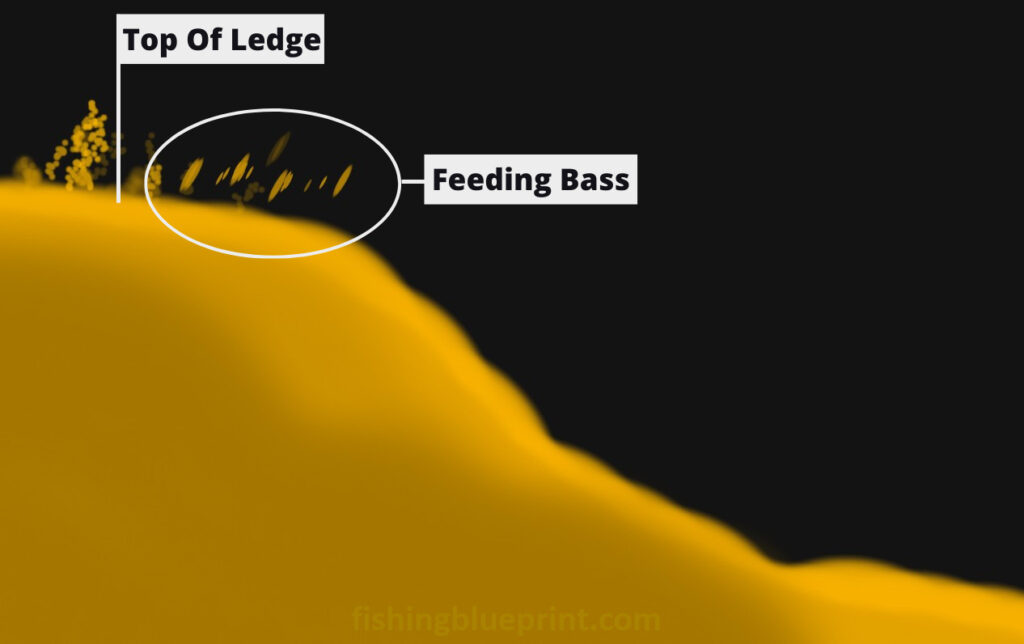
The bass will suspend above the deeper water, such as a creek channel or major river channel, when they are not actively feeding. As an illustration in the picture below, they won’t be placed on top of the ledge, but over deeper water instead.
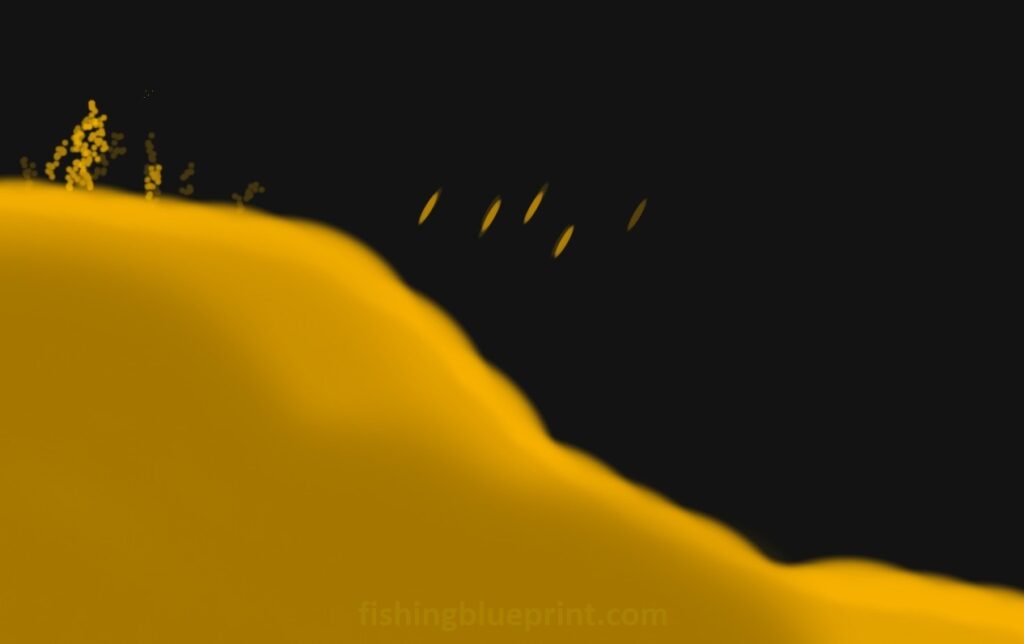
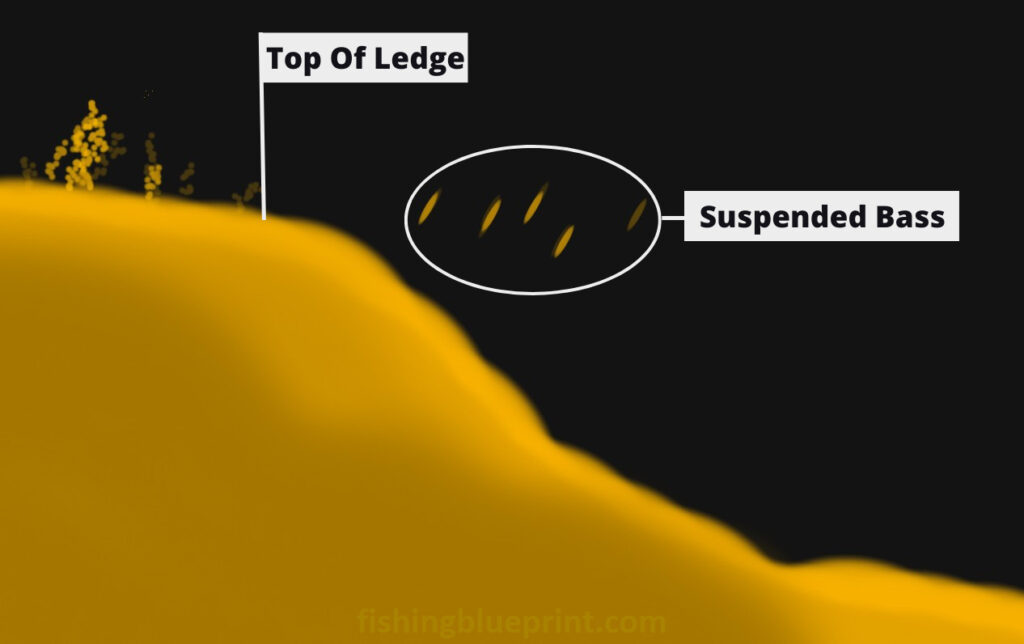
Helpful Tip: The creek channel is a “road” on which bass travel to and from flats and swings to reach another area of the lake.
Step 5: Best Bass Fishing Creeks Tactics & Tips
Here are a few basic tips to help you catch bass once you identify a good-looking creek channel.
Start by acknowledging 3 things: time of year, water temperature, water clarity, current weather, previous weather patterns.
The season and water temperature will help narrow down at least ½ of a potential creek.
- If it’s the early spring/prespawn fish in the mouth of the creek, 1st or 2nd points within the creek mouth.
- Later on in the spawn look protected pockets in the backs of the creek.
- Early in the summer a large population of bass will move back to the main creek channel or back out to the mouth of the creek, or even the main lake.
- Fall bass will chase shad into the backs of the creeks, but tend to target deeper pockets versus shallow flats like they preferred in spawn.
- Winter bass will move back out to deeper water in the main lake or near the mouth of the cove. These fish tend to prefer areas that has more vertical structure
Once you figured out were in the creek the bass are most likely going to be here’s how to start catching them:
- Positioning your boat downstream from the natural current and cast upstream. Reeling in your lure, it is retrieved with the flowing current and looks more natural.
- Use spot-lock on your trolling motor (if you have it), or try to remember the exact positioning where you caught the bass including boat angler and positioning. Sometimes bass will stack up on a spot just a couple of feet wide and if you lure it out of the strike range they won’t eat it.
- If you’re fishing close to shore avoid getting too close to your target, so may spook the fish… especially if the water is clear.
- When fishing isolated structures (such as a dock), like I discussed earlier, I always recommend fishing the outside corners first. Then work your bait down each side, then target the middle or under the structure.
- If you’re shallow in <5-feet of water turn off your electronics and stay as quiet as you can. Bass get very skittish when they’re shallow and any noise will spook them off.
- If you’re fishing offshore use a marker buoy 10 to 15-feet off the side of a specific structure you are trying to fish.
- Similar to shoreline fishing, don’t get too close to the mid creek structure, you could spook the fish.
When choosing what bait you should you here’s a quick and easy list that helps me:
- Topwater lures, buzzbaits in the morning or on cloudy conditions.
- Crankbaits, spinnerbaits, jerkbaits, chatterbaits, umbrella rigs, underspin jigs, swim jigs, hair jigs, lipless crankbaits, and soft plastic swimbaits, perform well here in breezy conditions or during the midday.
- In contrast, slower moving baits such as drop shot, football jigs, tubes, wacky rig, Texas rig, Neko rigs, and Carolina rigs can be phenomenal when the conditions are calm or the bass are holding close to the rocks.
- Flutter spoons work great in the deepest part of the point or over any secondary structures directly related to the creek.
My Final Private Notes...
With all of that said, I’ve fished a lot of creeks, and they can be a pretty darn good way to catch a TON of bass really fast.
At first I thought it was tough to initially get comfortable with creek fishing, but once I got out on the water and really started to use the free 7-step blueprint, I quickly saw my catch ratio explode!
So if you want to be successful, just remember the 5-steps to ledge fishing—find the right creek on the map first, choose the correct spots, identify the spot on your sonar and check for fish, cast your lures from downstream water, have all types of lures at the ready, choose only the best performing lures that are known to catch bass in creeks and creek channels.
This 5-step system simplifies the process when compared trying to wing it by yourself alone, and provides proven results that you integrate into fishing other types of fishing spots.
One last thing to keep in mind is that bass will move from spot to spot frequently on creeks. And even if the spot looks like it has all the right features, sometimes when you pull up and scan it it’s completely devoid of fish. Don’t worry about it, just move on to your next spot. Chances are your research and preparation are correct, but sometimes the bass are just not there—just come back to it later.
That’s it for now, take care and tight lines!
Want To Learn Where To Catch More Bass? Checkout These Articles...
- Bass Fishing CREEKS The Easy Way (In Less Than 10 Minutes)
- Warning: Bass Fishing HEAVY GRASS? [15+ Mistakes To Avoid]
- Bass Fishing POINTS in 5 Quick & EASY Steps!
- Complete 5-Step DOCK Fishing Formula
- Bass Fishing LAYDOWNS [Complete Guide + Pictures]
- Little Known Pattern for Fishing TREES for Bass.. Now and Forever
- Complete Formula For BASS FISHING ROCKY BANKS & RIPRAP
- The 5 TRUTHS about Bass Fishing BRIDGES and Avoid Wasting Time On Techniques That Don’t Work!
- Bass Fishing BRUSH PILES To Catch The Most Bass In Minimum Time!
- The 7-step Secret Formula for Bass Fishing LEDGES – Even a Complete Fishing Noob Can Use and Be 100 Times More Potent Than the Best B.A.S.S. Professional!
- The Single Best Guide to Fishing SHELL BEDS… and… Do It Fast!
- 5 Basic Elements Of Fishing HUMPS AND RIDGES No One is Talking About!
- 5 Crucial (and Unusual) Tactics You Must Do When Bass Fishing ROADBEDS!
- Top 25 Summer BANK Fishing Tips (Never Get Skunked Again)
- [EXPERT REVEALS] Bass Fishing In MUDDY WATER Secrets – 27 Tips & Mistakes To Avoid Today!
- 31 Best Tips for Bass Fishing At NIGHT (Complete Guide)
Checkout These Other Summer Fishing Articles...
- Complete 5-Step Formula For BASS FISHING DOCKS
- The 7-step Secret Formula for BASS FISHING LEDGES – Even a Complete Fishing Noob Can Use and Be 100 Times More Potent Than the Best B.A.S.S. Professional!
- Top 25 Summer Bank Fishing Tips (Never Get Skunked Again)
- Bass Fishing In Heavy Grass? [17+ Mistakes To Avoid]
- 7 Top Secret Weedless Bass Lures for Flipping into Heavy Grass -Exposed!
- How To Fish A Crankbait [TOP 10 Essential Secrets To Catching Bass With A Crankbait]
- 15 Best Deep Diving Crankbaits [2023 Buyers Guide – Which to Buy & Avoid]
- Fish a Flutter Spoon The RIGHT way... like the Pros... And Do It TODAY!
- NEW and truly "no brainer" (yet usually overlooked) way to MASTER SOFT PLASTIC PADDLE TAIL SWIMBAITS and increase the amount of bass you catch 100% or more... automatically!
- Top 5 questions and challenges every about hair jig fishing... AND how to overcome common problems most anglers encounter (and then prematurely quit).
- Top 10 Best Jigs For Bass Fishing [Insiders Only]
- Avoid this ONE Texas rig fishing NIGHTMARE - And increase your Texas rig fishing expertise FAST!
- 31 Best Tips for Bass Fishing At NIGHT (Complete Guide)
- 2023 Buyers Guide Best GREEN FISHING LIGHT [LED FISHING LIGHTS Reviews & Tips]
- Dock Lights For Night Fishing [Best Products, Secrets, & Tips]
Other Bass Fishing Articles Just For You...
Funny Fishing Rules, Laws, and Regulations 2025
Crazy Fishing Laws That Will Blow Your Mind! #7 is INSANE! Strange Fishing Regulations and Laws As silly as hook and rod limits may seem,
EXPOSED! How To Use A Spinnerbait The Right Way for 2025
Are You Wondering How To Use A Spinnerbait? Or How To Work A Spinnerbait Over Grass, Logs, or Points? Well, All These Questions Are Answered
EXPOSED! Best Crankbait Colors for 2025 [Which to Buy & Avoid]
What color crankbait to use? Crankbait Color Chart I just love going into a Bass Pro Shops store and just staring at all the walls
Best Underwater Dock Lights For Fishing – 2025 Buyers Guide
Night Dock Light Fishing For Beginners Dear fellow angler, Does this sound like you? You’re someone who loves fishing but just wants to escape the
15 Best Deep Diving Crankbaits [2025 Buyers Guide – Which to Buy & Avoid]
A Complete Buyer’s Blueprint On The Best Deep Diving Crankbaits for Bass, Walleye, or Striped Bass On The Market Today Fishing deep diving crankbaits can
